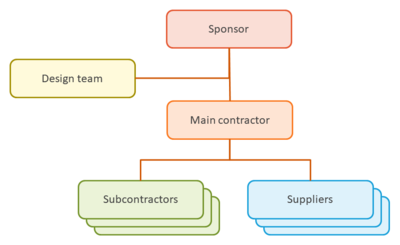Contractual relationship: Difference between revisions
Ceopediabot (talk | contribs) m (→Importance of contractual relationship: Typos, typos fixed: above mentioned → above-mentioned) |
|||
| Line 23: | Line 23: | ||
* '''Valid recognition of contractual terms''' | * '''Valid recognition of contractual terms''' | ||
These are special legal events occurring in the business relations in order to invite to undertake a commitment and then to accept it. However, it is important that all these activities are expressed in an understandable and unambiguous way so that the legitimacy of the relationship cannot be called into question at a later stage. | These are special legal events occurring in the business relations in order to invite to undertake a commitment and then to accept it. However, it is important that all these activities are expressed in an understandable and unambiguous way so that the legitimacy of the relationship cannot be called into question at a later stage. | ||
[[File:contractual_relationships.png|400px|right|thumb|Fig.1. Example of contractual relationships - construction project]] | |||
==Entering into contractual relationship== | ==Entering into contractual relationship== | ||
Revision as of 12:49, 31 August 2020
| Contractual relationship |
|---|
| See also |
Contractual relationship is the relationship between two or more parties to a contract. Created on the basis of a legal act, agreeing on mutually agreed terms and conditions. Inextricably linked with contract law, defining the rights and obligations of the parties to the legal relationship.
Manifestation of contractual relationship
The contractual relationship manifestation is expressed by:
- Presentation of the offer
- Acceptance of the offer
- Valid recognition of contractual terms
These are special legal events occurring in the business relations in order to invite to undertake a commitment and then to accept it. However, it is important that all these activities are expressed in an understandable and unambiguous way so that the legitimacy of the relationship cannot be called into question at a later stage.
Entering into contractual relationship
Entering into contractual relationship is made possible by the effective expression of a declaration of intent. However, in order to be effective, it must meet the following conditions:
- the person lodging it shall have the capacity to perform legal acts
- the activity which falls within the scope of the event was concluded in an appropriate legal form
- the declaration of intent is not vitiated by error
If at least one of the above things is not fulfilled positively, a situation will occur when the contractual relationship is not concluded correctly and consequently will be invalid from the very beginning[1].
Importance of contractual relationship
The objective of an effective contractual relationship is, first and foremost, to protect the interests of each party. This security feature prevents any abuse or potential exploitation. Additionally, it confirms all the provisions of the parties, being a reliable evidence of the occurrence of a specific event. It is realized by dividing the contractual relationship into, among others, the following sections:
- specify the parties to the relationship;
- obligations of the parties;
- safeguard clauses
- severance clauses;
- final provisions
The above-mentioned contractual relationship fragments are necessary and necessary for the proper conclusion of the relationship. Otherwise, it may result in the contractual relationship being void and the contract not being effectively concluded.
End of contractual relationship
Contractual relationship can be terminated in three different ways. They are as follows:
- dissolution
- withdrawal
- notice of termination
Dissolution - a consensual, mutual declaration of intent of each party aimed at terminating the legal relationship from the moment of concluding the agreement
Withdrawal - a consequence of breach of contract or improper performance of contractual provisions, resulting in the expiry of the legal relationship and characterized by the return by the parties of all benefits received so far.
Notice of termination - unilateral declaration of intent of one of the parties aimed at terminating the legal relationship with appropriate notice periods. It is important to distinguish between withdrawal and dissolution/notice of termination. This is due to the fact that the withdrawal is ex tunc (i. e. retroactive) and the dissolution and notice of termination is ex nunc (from the moment of the relevant declaration of intent)[2].
Breach of contract and contractual relationship
In the event of a breach of contract and its provisions, this may not always involve the complete termination of the contractual relationship. Very often, the contract provisions contain so-called severability clauses, which declare the contract invalid only in part, and not in full, so that the rest can be easily implemented further. [2] However, any such situation must be explicitly expressed at the time of the conclusion of the relationship, otherwise it will not be applicable and will therefore lead to the complete termination of the contract[3].
Footnotes
References
- Jelodar M. B., Yiu W. T., Wilkinson S., (2017). Assessing Contractual Relationship Quality: Study of Judgment Trends among Construction Industry Participants. "Journal of Management in Engineering", V.33, I. 1
- Lando O., (2000). Principles of European Contract Law. "Commission on European Contract Law", 146-148
- McKendrick E., (2014). Contract Law, Text, Cases and Materials, Sixth Edition. 139-141
- Smits J. M., (2010). The Right to Change Your Mind? Rethinking the Usefulness of Mandatory Rights of Withdrawal in Consumer Contract Law. "Penn State International Law Review", V.29, 671-684
Author: Jan Kaptur
